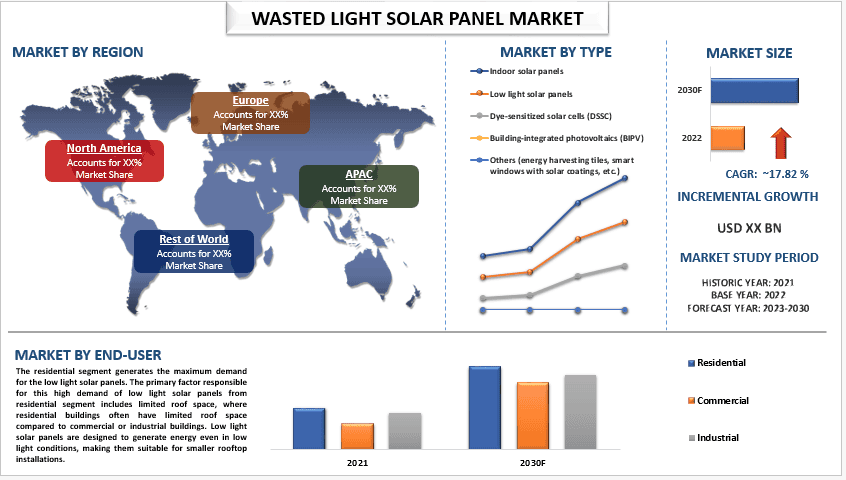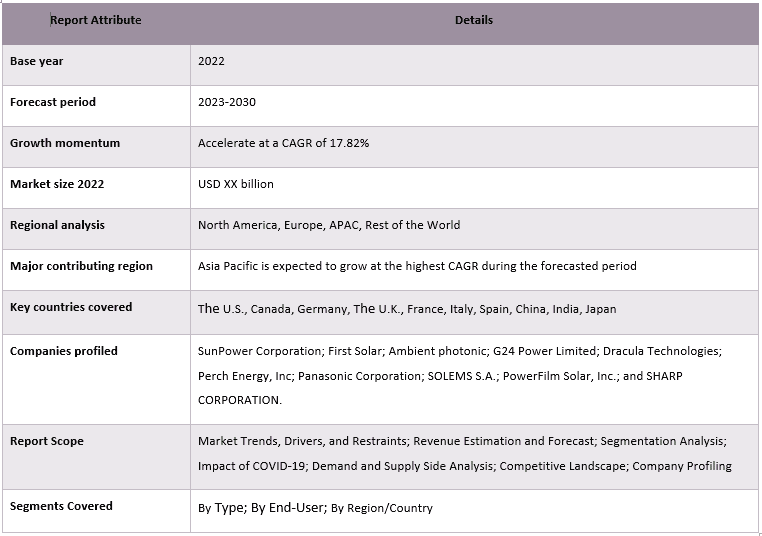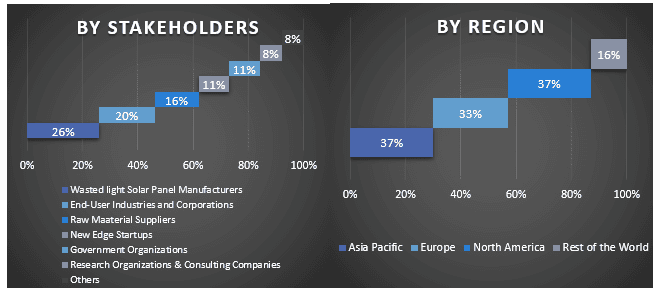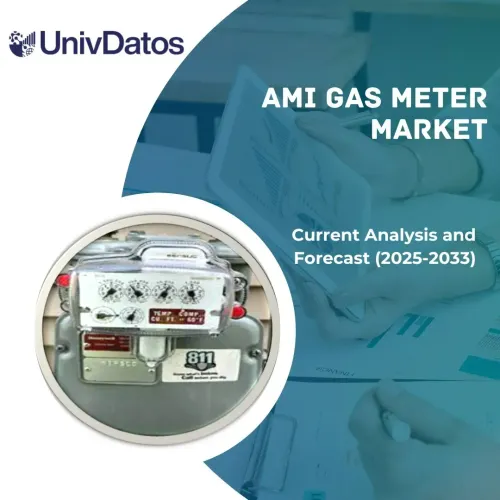- Home
- About Us
- Industry
- Services
- Reading
- Contact Us
Wasted Light Solar Panel Market: Current Analysis and Forecast (2023-2030)
Emphasis on Type (indoor Solar Panels, Low Light Solar Panels, Dye-Sensitized Solar Cells (DSSC), Building Integrated Photovoltaics (BIPV), and Others (Energy Harvesting Tiles, Smart Windows with Solar Coatings, etc.)), End-User Industry (Residential, Commercial, and Industrial); and Region/Country

The Wasted Light Solar Panel Market was valued at X billion in the year 2022 and is expected to grow at a strong rate of around 17.82% during the forecast period (2023-2030), owing to the exponential rise in the renewable energy resources adoption and increased investments in the sustainable solutions of energy generation. The primary reason for the growing traction of the low light solar panels include low light solar panels are engineered to be more efficient and effective in harnessing energy from ambient light sources such as cloudy skies, shaded areas, and even indoor lighting. This makes them advantageous in regions with frequent cloud cover, shorter daylight hours, or locations where direct sunlight exposure isn’t possible. Furthermore, the technology behind low light solar panels involves the use of advanced semiconductor materials, such as amorphous silicon or thin-film solar cells, which have higher sensitivity to a broader spectrum of light wavelengths. These materials allow the panels to capture and convert a wider range of the available light spectrum, including infrared and ultraviolet light, which are abundant even in low light conditions. Factors like this are contributing to the growth of the low light or ambient light solar panels in the market and due to factors like this an array of investments and product launches are happening in this space. For instance, Chicony and Ambient Photonics announced a partnership for developing a battery free wireless keyboard, which will be powered by ambients low light solar photovoltaic cells.
Some of the major players operating in the market include SunPower Corporation; First Solar; Ambient photonic; G24 Power Limited; Dracula Technologies; Perch Energy, Inc; Panasonic Corporation; SOLEMS S.A.; PowerFilm Solar, Inc.; and SHARP CORPORATION. Several M&As along with partnerships have been undertaken by these players to facilitate customers with hi-tech and innovative products/technologies.
Insights Presented in the Report
“Amongst type, the Dye-Sensitized Solar Cells (DSSC) segment held the significant share of the market in 2022.”
Based on type, the market is segmented into indoor solar panels, low light solar panels, dye-sensitized solar cells (DSSC), building integrated photovoltaics (BIPV), and others (energy harvesting tiles, smart windows with solar coatings, etc.). The dye-sensitized solar cells (DSSC) hold most of the low light solar panels market. The primary factor responsible for this domination includes efficiency, where DSSCs have demonstrated high power conversion efficiency, which is comparable to conventional silicon-based solar cells. Furthermore, DSSCs can operate under various lighting conditions, including low-light and indoor environments. This versatility makes them suitable for a wide range of applications, such as portable electronics, building-integrated photovoltaics, and even clothing. Additionally, DSSCs offer the potential for large-scale production due to their relatively simple manufacturing processes. As the demand for renewable energy continues to grow, there are opportunities for scaling up production and reducing costs even further.
“Amongst end-user industry, the residential segment is anticipated to grow at a significant CAGR during the forecast period (2023-2030).”
Based on end-user industry, the market is segmented into residential, commercial, and industrial. The residential segment generates the maximum demand for the low light solar panels. The primary factor responsible for this high demand of low light solar panels from residential segment includes limited roof space, where residential buildings often have limited roof space compared to commercial or industrial buildings. Low light solar panels are designed to generate energy even in low light conditions, making them suitable for smaller rooftop installations. Moreover, many residential areas have shading issues due to nearby buildings, trees, or other obstructions. Low light solar panels are better at capturing and converting sunlight in shaded conditions, making them an ideal choice for residential rooftops where shading may be present. Furthermore, residential buildings often have consistent energy demand throughout the day, with higher energy consumption during mornings and evenings. Low light solar panels are designed to produce electricity even during these times when sunlight may not be at its peak, allowing residents to meet their energy needs more effectively.
“Asia Pacific to lead the growth in the wasted light solar panel segment during the forecasted period (2022-2030).”
The Asia Pacific region has seen a surge in the adoption of low light solar cells, with China leading the way. This growth is driven by a variety of factors, including government initiatives, where governments in the Asia Pacific region have been actively promoting the adoption of low light solar cells. In China, the government has implemented a range of policies to encourage the development and use of renewable energy sources, including low light solar cells. These policies include subsidies, tax incentives, and other measures to reduce the cost of solar energy. Furthermore, Asia Pacific region has a robust manufacturing industry and a large pool of skilled labor. This has enabled the region to produce low light solar cells at a lower cost than other regions. Moreover, growing urbanization is a major driver of the growth of low light solar cells in the Asia Pacific region. As cities grow, the demand for energy increases, and solar energy is becoming an increasingly attractive option. Additionally, the decreasing cost of low light solar panels, making them more affordable for consumers driven by factors, including government initiatives, technological advances, and economies of scale. As the cost of solar energy continues to decrease, more people in the Asia Pacific region are likely to adopt low light solar cells.
Wasted Light Solar Panel Market Report Coverage

Reasons to buy this report:
- The study includes market sizing and forecasting analysis validated by authenticated key industry experts.
- The report presents a quick review of overall industry performance at one glance.
- The report covers an in-depth analysis of prominent industry peers with a primary focus on key business financials, product portfolios, expansion strategies, and recent developments.
- Detailed examination of drivers, restraints, key trends, and opportunities prevailing in the industry.
- The study comprehensively covers the market across different segments.
- Deep dive regional level analysis of the industry.
Customization Options:
The global wasted light solar panel market can further be customized as per the requirement or any other market segment. Besides this, UMI understands that you may have your own business needs, hence feel free to contact us to get a report that completely suits your requirements.
Table of Content
Research Methodology for the Wasted Light Solar Panel Market Analysis (2023-2030)
Analyzing the historical market, estimating the current market, and forecasting the future market of the global wasted light solar panel market were the three major steps undertaken to create and analyze the adoption of wasted light solar panel in major regions globally. Exhaustive secondary research was conducted to collect the historical market numbers and estimate the current market size. Secondly, to validate these insights, numerous findings and assumptions were taken into consideration. Moreover, exhaustive primary interviews were also conducted, with industry experts across the value chain of the global wasted light solar panel market. Post assumption and validation of market numbers through primary interviews, we employed a top-down/bottom-up approach to forecasting the complete market size. Thereafter, market breakdown and data triangulation methods were adopted to estimate and analyze the market size of segments and sub-segments of the industry pertains to. Detailed methodology is explained below:
Analysis of Historical Market Size
Step 1: In-Depth Study of Secondary Sources:
A detailed secondary study was conducted to obtain the historical market size of the wasted light solar panel market through company internal sources such as annual reports & financial statements, performance presentations, press releases, etc., and external sources including journals, news & articles, government publications, competitor publications, sector reports, third-party database, and other credible publications.
Step 2: Market Segmentation:
After obtaining the historical market size of the wasted light solar panel market, we conducted a detailed secondary analysis to gather historical market insights and share for different segments & sub-segments for major regions. Major segments are included in the report as type and end-user industry. Further country-level analyses were conducted to evaluate the overall adoption of testing models in that region.
Step 3: Factor Analysis:
After acquiring the historical market size of different segments and sub-segments, we conducted a detailed factor analysis to estimate the current market size of the Wasted Light Solar Panel market. Further, we conducted factor analysis using dependent and independent variables such as type and end-user industry of the wasted light solar panel market. A thorough analysis was conducted for demand and supply-side scenarios considering top partnerships, mergers and acquisitions, business expansion, and product launches in the wasted light solar panel market sector across the globe.
Current Market Size Estimate & Forecast
Current Market Sizing: Based on actionable insights from the above 3 steps, we arrived at the current market size, key players in the global Wasted Light Solar Panel market, and market shares of the segments. All the required percentage shares split, and market breakdowns were determined using the above-mentioned secondary approach and were verified through primary interviews.
Estimation & Forecasting: For market estimation and forecast, weights were assigned to different factors including drivers & trends, restraints, and opportunities available for the stakeholders. After analyzing these factors, relevant forecasting techniques i.e., the top-down/bottom-up approach, were applied to arrive at the market forecast for 2030 for different segments and sub-segments across the major markets globally. The research methodology adopted to estimate the market size encompasses:
- The industry’s market size, in terms of revenue (USD) and the adoption rate of the wasted light solar panel market across the major markets domestically
- All percentage shares, splits, and breakdowns of market segments and sub-segments
- Key players in the global wasted light solar panel market in terms of products offered. Also, the growth strategies adopted by these players to compete in the fast-growing market.
Market Size and Share Validation
Primary Research: In-depth interviews were conducted with the Key Opinion Leaders (KOLs) including Top Level Executives (CXO/VPs, Sales Head, Marketing Head, Operational Head, Regional Head, Country Head, etc.) across major regions. Primary research findings were then summarized, and statistical analysis was performed to prove the stated hypothesis. Inputs from primary research were consolidated with secondary findings, hence turning information into actionable insights.
Split of Primary Participants in Different Regions

Market Engineering
The data triangulation technique was employed to complete the overall market estimation and to arrive at precise statistical numbers for each segment and sub-segment of the global wasted light solar panel market. data was split into several segments & sub-segments post studying various parameters and trends in the areas of the type and end-user industry in the global wasted light solar panel market.
The main objective of the Global Wasted Light Solar Panel Market Study
The current & future market trends of the global wasted light solar panel market were pinpointed in the study. Investors can gain strategic insights to base their discretion for investments on the qualitative and quantitative analysis performed in the study. Current and future market trends determined the overall attractiveness of the market at a regional level, providing a platform for the industrial participant to exploit the untapped market to benefit from a first-mover advantage. Other quantitative goals of the studies include:
- Analyze the current and forecast market size of the wasted light solar panel market in terms of value (USD). Also, analyze the current and forecast market size of different segments and sub-segments.
- Segments in the study include areas of type and end-user industry.
- Define and analyze the regulatory framework for the wasted light solar panel
- Analyze the value chain involved with the presence of various intermediaries, along with analyzing customer and competitor behaviors of the industry
- Analyze the current and forecast market size of the wasted light solar panel market for the major region
- Major countries of regions studied in the report include Asia Pacific, Europe, North America, and the Rest of the World
- Company profiles of the wasted light solar panel market and the growth strategies adopted by the market players to sustain in the fast-growing market
- Deep dive regional level analysis of the industry
Frequently Asked Questions FAQs
Q1: What is the current market size and growth potential of the global Wasted Light Solar Panel market?
Q2: What are the driving factors for the growth of the global Wasted Light Solar Panel Market?
Q3: Which segment has the largest share of the global Wasted Light Solar Panel market by Type?
Q4: What are the emerging technologies and trends in the global Wasted Light Solar Panel market?
Q5: Which region will dominate the global Wasted Light Solar Panel market?
Q6: Who are the key players operating in the global Wasted Light Solar Panel market?
Related Reports
Customers who bought this item also bought










